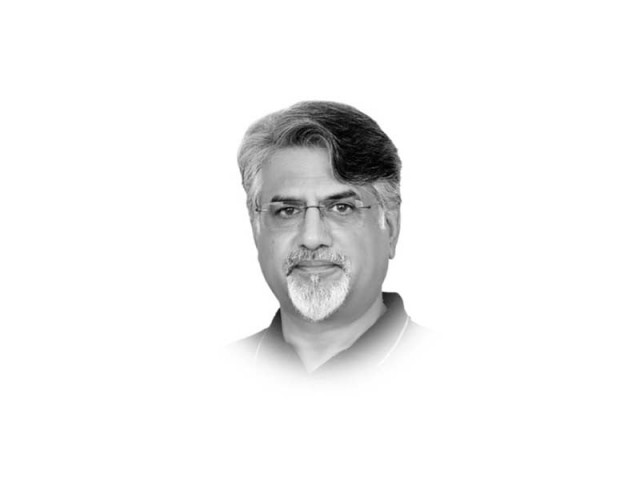Pakistan's gateway dilemma
Our location matters to great powers, it is here that Heartland powers, maritime powers intersect.

The Geographical Pivot of History and Democratic Ideals and Reality are two great scholarly writings by Sir Halford Mackinder, who is considered one of the founding fathers of both geopolitics and geostrategy. The former was written a decade before the commencement of WWI, and the latter appeared in the same year as the Versailles Conference. The first gave us the Heartland Theory, and the second expanded it to connect it with moral, political and institutional questions.
Considering that Pakistan lies on the periphery of Mackinder's Heartland, I would like to describe the challenges Pakistan faces as it tries to balance in the struggle between the sea powers and the land powers to dominate the Heartland. Doing this, I would also like to propose that Mackinder's Heartland Theory is very much relevant, and the technological advancement and growth of air power have not rendered the theory meaningless, as some scholars of international relations consider. Advancement of technology has contributed to the collapse of time and distance, but the crisis of the room, the geographical space, and the pivot of history remains very much relevant. Heartland and its importance are very much relevant.
Mackinder's Heartland is the vast interior of Eurasia (Central Asia, Russia, and part of Eastern Europe), being landlocked and protected by natural barriers (ice to the north and mountains and deserts to the south). The sea powers always found it difficult to invade the Heartland, and they still do, but the land powers, such as France and Germany, could project their power overland. Napoleon and Hitler both ventured into the Heartland with big armies.
Mackinder's Heartland Theory influenced strategy and geopolitics during WWI and WWII and also during the Cold War. The theory is still relevant, and for Pakistan to survive the great powers' security competition that it invites, it must correctly align and balance its democratic ideals with the geopolitical geography that surrounds it.
Pakistan's strategic vitality emanates from its ability to connect the land powers of Eurasia to the Sea powers of the Indian Ocean. Pakistan's physical layout is at the crossroads of three strategic regions: the Middle East, Central Asia, and South Asia, thus making us a geographical hinge for Mackinder's Heartland. Our location matters to great powers because it is here that Heartland powers (Russia and China) and maritime powers (the US, Britain and India) intersect.
For Russia, we are the backdoor access to Heartland through our warm water ports, and for China, we provide the route to Xinxiang and connect it to the Arabian Sea through our deep ports. If our geography makes us crucial to both the land powers and the sea powers, then it surely makes us, in Mackinder's words, a pivot state that links the Heartland to the Sea.
For China, Pakistan serves the twin purpose of not only helping her to operationalise the linkage of Heartland to Arabian Sea via Pakistan but also helping her to bypass the US-controlled maritime chokepoint of Strait of Malacca. Pakistan stands out as a pivot state that is destined to play an important role in the future to unite the Eurasian landmass through Chinese-invested infrastructure and trade to the rest of the world.
Russia, the original Heartland power and the power that garrisons Heartland, is eagerly looking towards Pakistan to develop ties in many areas, including the buildup of an energy corridor through Central Asia to Pakistan. Not through conflict but through cooperation, Russia seeks Mackinder's Heartland's drive towards the southern outlet of the warm waters.
Both China and Russia disapprove American strategy of controlling the coastal edges of Eurasia. They believe that if America can have the Monroe Doctrine, so can the other great powers, and therefore all-American investment in the Rimland States is seen as interference in their sphere of influence and thus disapproved and challenged by both the great powers. Pakistan's big coastline and its proximity to Gulf States, Iran and India, and the likelihood of this coast being utilised by the competing great powers, propel Pakistan to the status of a maritime power, the utility of whose coast may determine the future Rimland stability. The US aims to contain China as well as stabilise Afghanistan, and it cannot do both without relying on Pakistan.
In Mackinder's words, it would mean a grand strategy of a sea power that aims at preventing the Heartland powers (China and Russia) from reaching the Rimland (Arabian Sea). Put simply, if strategy is the bridge between desire and possibility, then Pakistan is a bridge for two entirely different grand strategies in the region - the Heartland powers (China and Russia) grand strategy of reaching the Rimland (Arabian Sea) and the sea power (United States) grand strategy of preventing the Heartland powers from reaching the Arabian Sea through Pakistan. The big question that Pakistan needs to answer is on which side it stands. On the side of Heartland integration, with China and Russia; or on the side of Heartland and Rimland containment (United States and India).
India is aligned with the United States and its Indo-Pacific strategy, which is Rimland-focused and aims at safeguarding sea lanes and containing China. India supports the American efforts of containing China's continental advance towards Rimland ports. Seen in this context, Pakistan virtually sits between the United States and India's Rimland posture and China and Russia's Heartland outreach. This for Pakistan creates a classic 'gateway dilemma'. Even a blind man can see that instability in Afghanistan directly affects Pakistan's security and connectivity. Afghanistan is the corridor and extension to the Heartland's continental integration. Therefore, how we treat Afghanistan can create for Pakistan a great strategic opportunity or, conversely, add to our own troubles by creating on our doorsteps a permanent security liability.
The Margalla Security Dialogue is being held next week. It is an annual Track 1.5 initiative organised by the Islamabad Policy Research Institute (IPRI) that aims to foster academic and policy discussions on issues related to peace, development and security, with a particular focus on Pakistan, South Asia, the Middle East, Central Asia (SAMECA), and the broader global context.
Some distinguished speakers have been invited to grace the occasion; and being part of the audience, I will have my fingers crossed to see which side of the world Pakistan stands as a state that resides on the periphery, but which can play a pivotal role in the future of Heartland.















COMMENTS
Comments are moderated and generally will be posted if they are on-topic and not abusive.
For more information, please see our Comments FAQ